Why Your Business Needs a Strong Digital Foundation
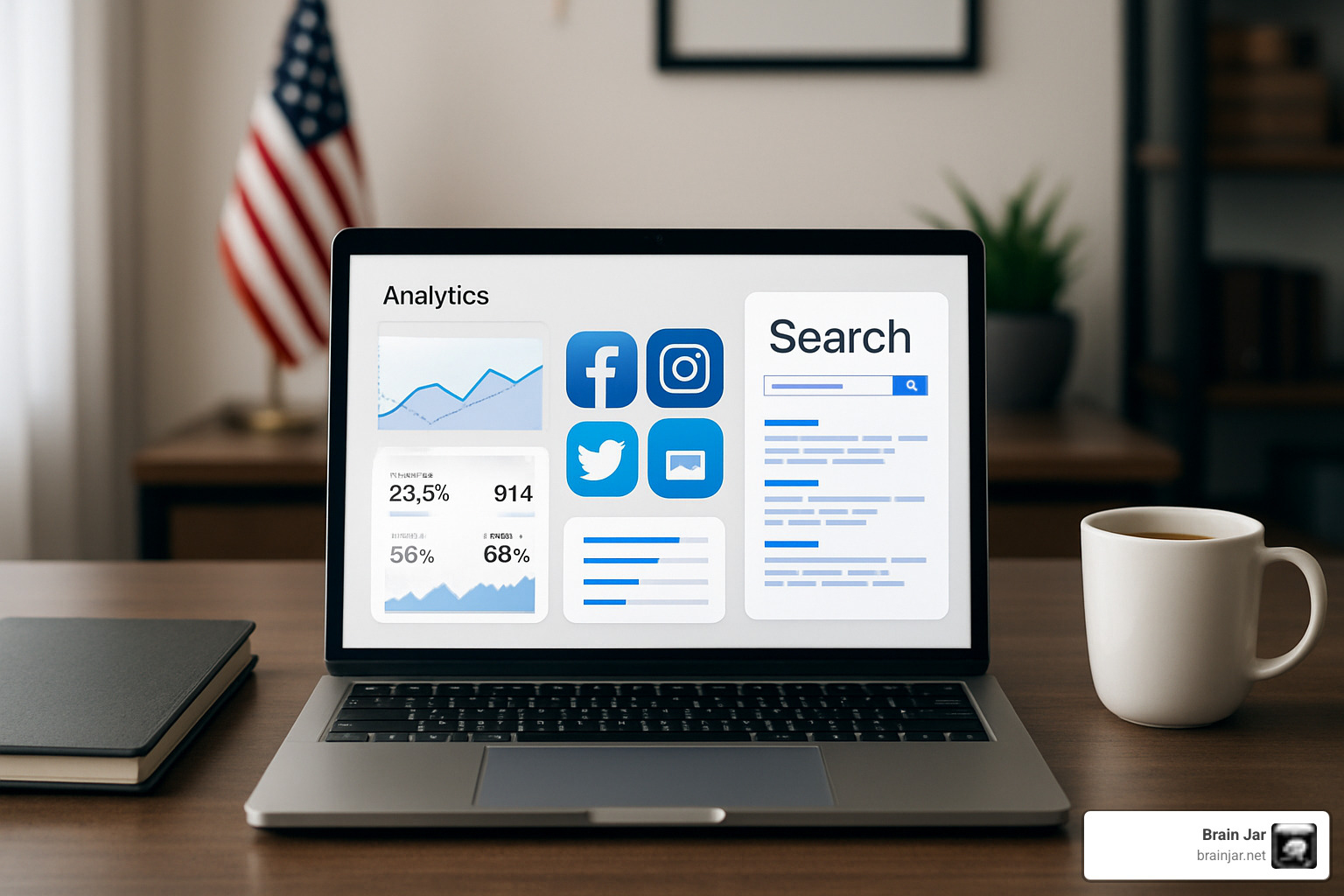
Online presence management is the strategic process of controlling and optimizing how your business appears across all digital channels – from search engines and social media to review sites and online directories. It’s about creating a unified, professional image that builds trust and drives customers to choose you over competitors.
What Online Presence Management Includes:
- Website optimization – Fast, mobile-friendly site with clear messaging
- Search engine visibility – Appearing when customers search for your services
- Social media management – Consistent posting and community engagement
- Review management – Monitoring and responding to customer feedback
- Online listings – Accurate business information across directories
- Content marketing – Valuable content that showcases expertise
- Crisis management – Quick response to negative situations
The numbers tell a compelling story: 86% of the global population uses social media, while 98% of potential customers rarely visit page 2 of search results. Even more striking, 93% of consumers say online reviews impact their purchasing decisions, and 82% were convinced to purchase because of an online review.
This means every interaction a customer has with your brand online shapes their decision to buy from you. Without active management, you’re leaving that crucial first impression to chance.
I’m HJ Matthews, Business Development Manager at Brain Jar, and I’ve spent over 15 years helping businesses across industries build stronger online presence management strategies. Through managing my own online ventures and working with diverse clients, I’ve seen how the right approach can transform a business’s digital footprint and drive real growth.
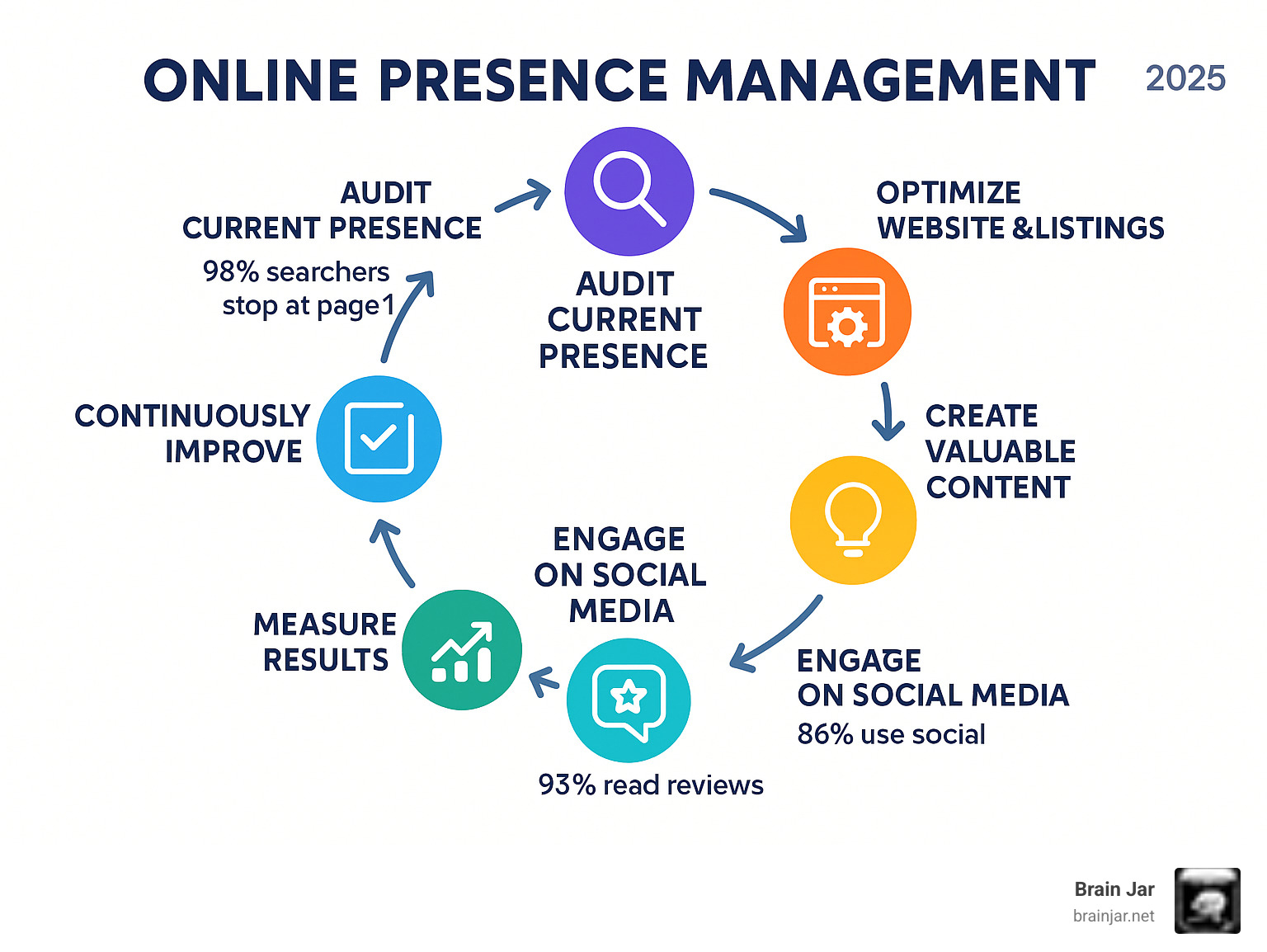
Understanding Online Presence Management
Think of online presence management as being the director of your own digital movie. Instead of letting random scenes play out across the internet, you’re crafting a cohesive story that shows your business in the best light.
This isn’t just marketing – it’s digital governance. Every piece of content, every review response, and every social media post either builds or breaks the trust you’ve worked so hard to earn.
What Is Online Presence Management?
Online presence management is your holistic strategy for controlling how your business appears everywhere online. It combines your owned media (like your website and social profiles) with earned media (customer reviews and mentions) to create one unified brand experience.
Instead of managing each platform separately, you’re orchestrating them together. Your website content supports your social media posts. Your review responses reflect your brand voice. Your local listings match your website information perfectly.
Online Presence Management vs. Web Presence & Reputation Management
Web presence management typically focuses on the technical side – governance, risk, and compliance. Reputation management zeroes in on review sites and crisis response, dealing with problems after they happen.
Online presence management is much broader. It’s about narrative control across every digital touchpoint. Instead of just putting out fires, you’re building a strong foundation that prevents many problems from happening in the first place.
Why Proactive Online Presence Management Matters
Businesses with strong online presence see real revenue impact – research shows that even a one-star rating difference can change restaurant revenue by 5-9%. More importantly, 63% of consumers will pay up to 15% more when they’re convinced they’ll get a better experience.
When someone searches for your services, they’re making trust decisions. A professional website, positive reviews, and active social media presence all signal reliability and quality.
Without proactive management, you’re letting chance determine your first impression. Scientific research on digital reputation shows how quickly online perceptions form and how hard they are to change.
Auditing & Assessing Your Current Presence
Think of your digital audit like getting a health checkup – you can’t fix what you don’t know is broken. Many business owners assume they know how they appear online, but the reality is often quite different.
Step-by-Step Digital Audit
Start with the basics: Google your business name. Check the first three pages of results, then look at Google Images, News, and Videos tabs. You might be surprised what shows up.
Next, expand your search to include key personnel and your primary services. Are you showing up when people search for what you do? 98% of potential customers rarely visit page 2 of search results, so if you’re not on page one, you’re essentially invisible.
Social media scanning means checking all major platforms – not just the ones you use. Customers might be talking about your business on Facebook even if you only post on Instagram.
Review scraping involves systematically checking Google Reviews, Yelp, Facebook, and any industry-specific review sites. Set up a simple spreadsheet to track what you find.
Website performance is crucial too. If your site loads slowly, you’re losing customers before they even see your content. If you’re experiencing performance problems, understanding why your website is loading slowly can help identify specific fixes.
Key Metrics & Benchmarks
Domain Authority scores your website’s credibility on a scale from 1 to 100. Don’t panic if your score seems low – it’s relative to your industry and competition.
Share of voice measures how often your brand gets mentioned compared to competitors. This reveals whether you’re part of the conversation in your industry.
For website traffic, aim for 50-70% of visitors from non-branded organic traffic. This means people are finding you through searches for your services, not just your business name.
Review volume and velocity matter tremendously. Research shows that 25% of consumers begin to trust a rating once it has 11-50 reviews, while 19% require 51-100 reviews before they feel confident.
Social media engagement rates vary by platform, but consistency beats perfection every time. A business that posts regularly and responds to comments will outperform one that posts sporadically.
Strategies & Best Practices for Boosting Visibility & Reputation
Building a strong online presence management strategy isn’t about doing everything at once – it’s about creating a coordinated effort where each piece reinforces the others.
Search Engine Optimization Essentials
When someone searches for your services, you want to be the first name they see. 68% of marketers recognize the importance of aligning content with the buyer’s journey, which means understanding what your customers are actually looking for.
Start with keyword research to find how people search for businesses like yours. Schema markup helps search engines understand your content better, while technical SEO ensures your site loads quickly and works perfectly on mobile devices.
On-page optimization includes crafting compelling title tags and meta descriptions. Backlink outreach builds your site’s authority by earning links from reputable sources.
Our SEO Services – Gold Plan handles these complex elements while focusing on sustainable growth that lasts.
Leveraging Social Media Platforms
89% of marketers worldwide use Facebook, but that doesn’t mean it’s right for every business. Instagram achieves 0.60% engagement compared to Facebook’s 0.15%, but the audience and content style are completely different.
Platform selection should match where your customers actually spend their time. The key is choosing platforms you can maintain consistently rather than spreading yourself too thin.
Content pillars help you stay consistent while keeping things interesting. Community building goes beyond posting content. 63% of customers expect social media customer service, so responding quickly to comments and messages is essential.
Our Social Media Management Plan helps businesses maintain a consistent presence while adapting content to each platform’s unique characteristics.
Managing Online Reviews & Customer Feedback
Reviews are today’s word-of-mouth recommendations. 95% of customers spread the word online and offline when a business interaction goes badly, but only 47% proactively share positive experiences.
This means you need systems to encourage happy customers to leave reviews. Simple follow-up emails with direct links to review platforms can dramatically increase your review volume.
Response etiquette matters for both positive and negative reviews. Thank positive reviewers by name and mention specific points they raised. For negative reviews, respond professionally and offer to resolve issues privately.
60% of consumers avoid businesses with negative reviews, but 45% might still consider them if criticism is handled well.
Crisis & Reputation Safeguarding
Monitoring alerts for your brand name help you catch issues early when they’re easier to address. Your crisis playbook should include pre-approved response templates for common situations.
Speed matters in crisis response. Having designated team members and clear escalation paths ensures nothing falls through the cracks during stressful times.
Transparency builds trust, even in difficult situations. Customers appreciate honest communication about problems and solutions.
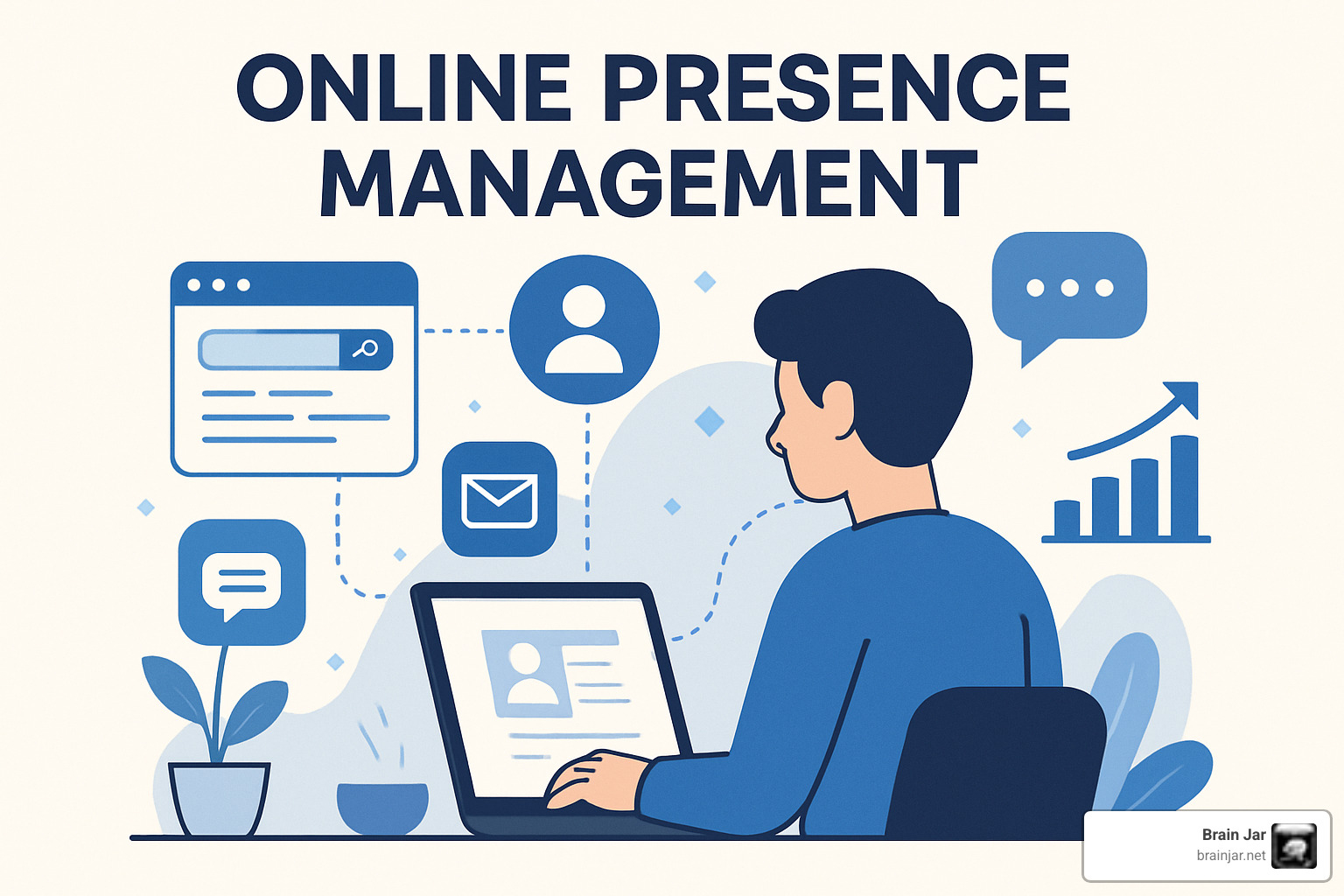
Tools & Technologies That Make It Easier
Managing your online presence management effectively requires the right technology stack. The difference between businesses that struggle with digital marketing and those that thrive often comes down to having tools that work together seamlessly.
Must-Have Tool Categories for Online Presence Management
Brand monitoring tools serve as your digital ears, tracking mentions across social media, news sites, forums, and review platforms. These provide real-time alerts when someone talks about your brand.
Social media management systems transform chaos into order by letting you schedule posts, track engagement, and manage multiple accounts from one central dashboard.
SEO audit tools act like health checkups for your website, identifying technical issues that might be hurting your search rankings. They track keyword positions and monitor backlink profiles.
Listing management platforms ensure your business information stays consistent across hundreds of online directories. Inconsistent business information confuses both customers and search engines.
Reputation management software aggregates reviews from multiple platforms and can automate review requests to satisfied customers. Since 93% of consumers say online reviews impact their purchasing decisions, having a systematic approach can significantly impact your bottom line.
Analytics dashboards tie everything together by showing how different channels contribute to your overall business goals.
| Tool Category | Key Features | Typical Cost Range | Learning Curve |
|---|---|---|---|
| Brand Monitoring | Real-time alerts, sentiment analysis, competitor tracking | $50-$500/month | Low to Medium |
| Social Media Management | Post scheduling, multi-platform management, analytics | $30-$300/month | Low |
| SEO Audit | Keyword tracking, technical audits, backlink monitoring | $100-$400/month | Medium |
| Listing Management | Directory sync, duplicate detection, review aggregation | $50-$200/month | Low |
| Reputation Management | Review monitoring, response templates, sentiment tracking | $100-$500/month | Medium |
| Analytics Dashboards | Multi-channel reporting, ROI tracking, custom metrics | $50-$1000/month | Medium to High |
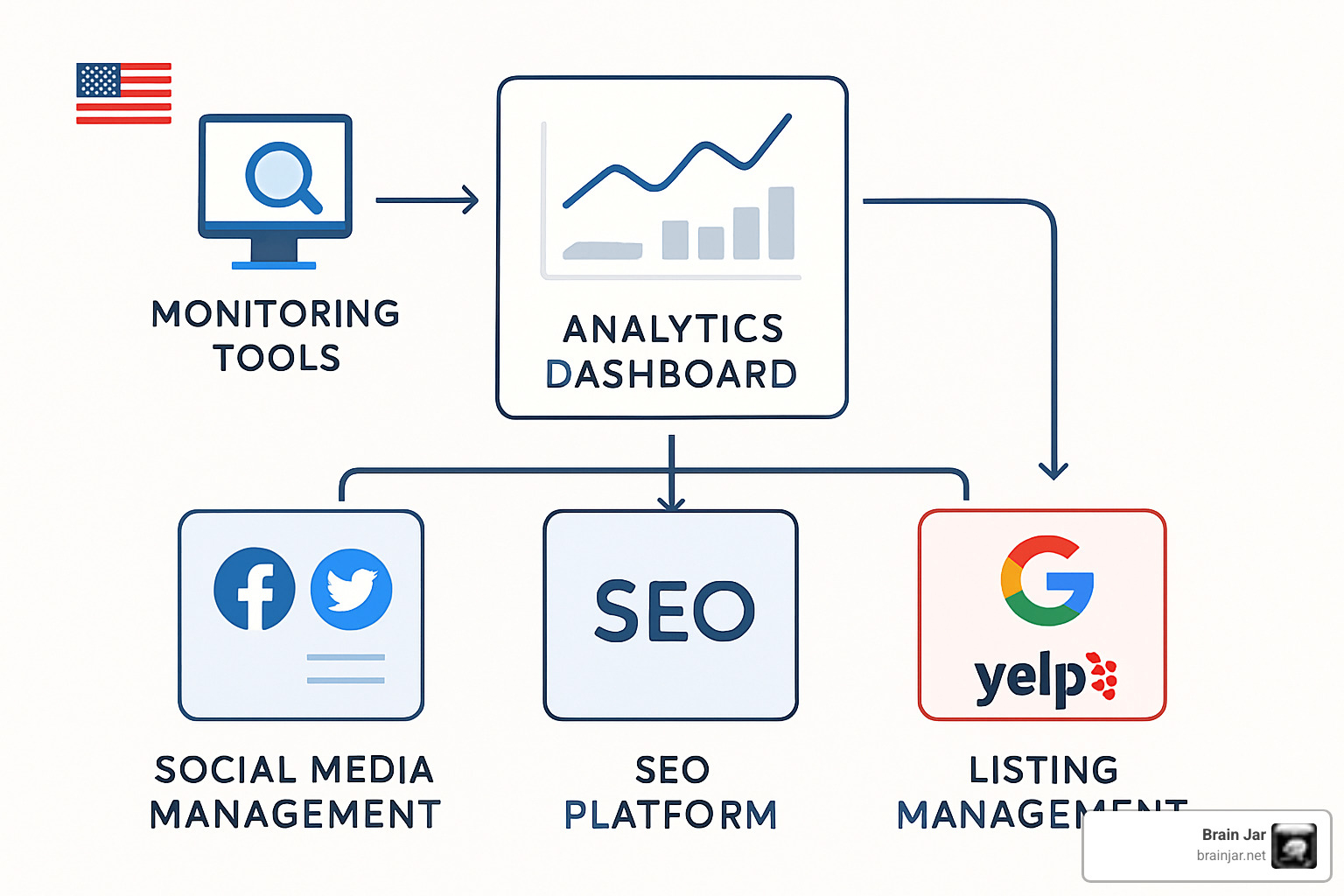
Selecting the Right Stack
Budget alignment should be your starting point, but think long-term rather than just monthly costs. Start with essential tools and add capabilities as your business grows.
Scalability ensures your tools can handle increased activity without requiring complete replacement. Ease of use matters more than you might think. The most sophisticated platform won’t help if your team avoids using it.
Integration capabilities prevent data silos and reduce manual work. Tools that connect to each other provide more comprehensive insights than standalone solutions.
Consider your team’s technical skills honestly when selecting tools. The best tool is the one your team will actually use consistently.
Measuring Success & Continuous Improvement
The real test of online presence management isn’t how many likes you get – it’s whether your digital efforts actually grow your business. The key is focusing on what actually matters and building systems that help you improve over time.
Defining KPIs That Matter
Traffic quality beats quantity every time. You want 50-70% of your website visitors coming from non-branded organic traffic – these are people who found you while searching for solutions, not folks who already knew your name.
Conversion rate shows how well your digital presence turns visitors into paying customers. Sentiment index tracks whether people are saying good or bad things about your brand online.
Review velocity measures how quickly you’re generating fresh reviews, while average response time shows how well you’re managing customer service across platforms.
Cost per lead helps you understand which channels give you the best return on investment. Choose metrics that align with your business goals – a local plumber cares more about phone calls than social media followers.
Reporting & Optimization Cadence
Monthly reviews hit the sweet spot for most businesses – enough data to spot real trends without getting lost in daily noise.
A/B testing different approaches keeps you improving over time. Try different social media post styles, email subject lines, or website headlines.
Content refresh keeps your information current and shows search engines that your site is actively maintained. Algorithm updates from major platforms can shake up your visibility overnight.
Competitor monitoring reveals new opportunities and potential threats. Having systems for updating and testing new approaches, like cloning and updating website content, helps you stay agile while maintaining consistency.
Regular optimization prevents your online presence from getting stale. Set up monthly check-ins to review your data, quarterly deep dives to spot bigger trends, and annual strategic reviews.
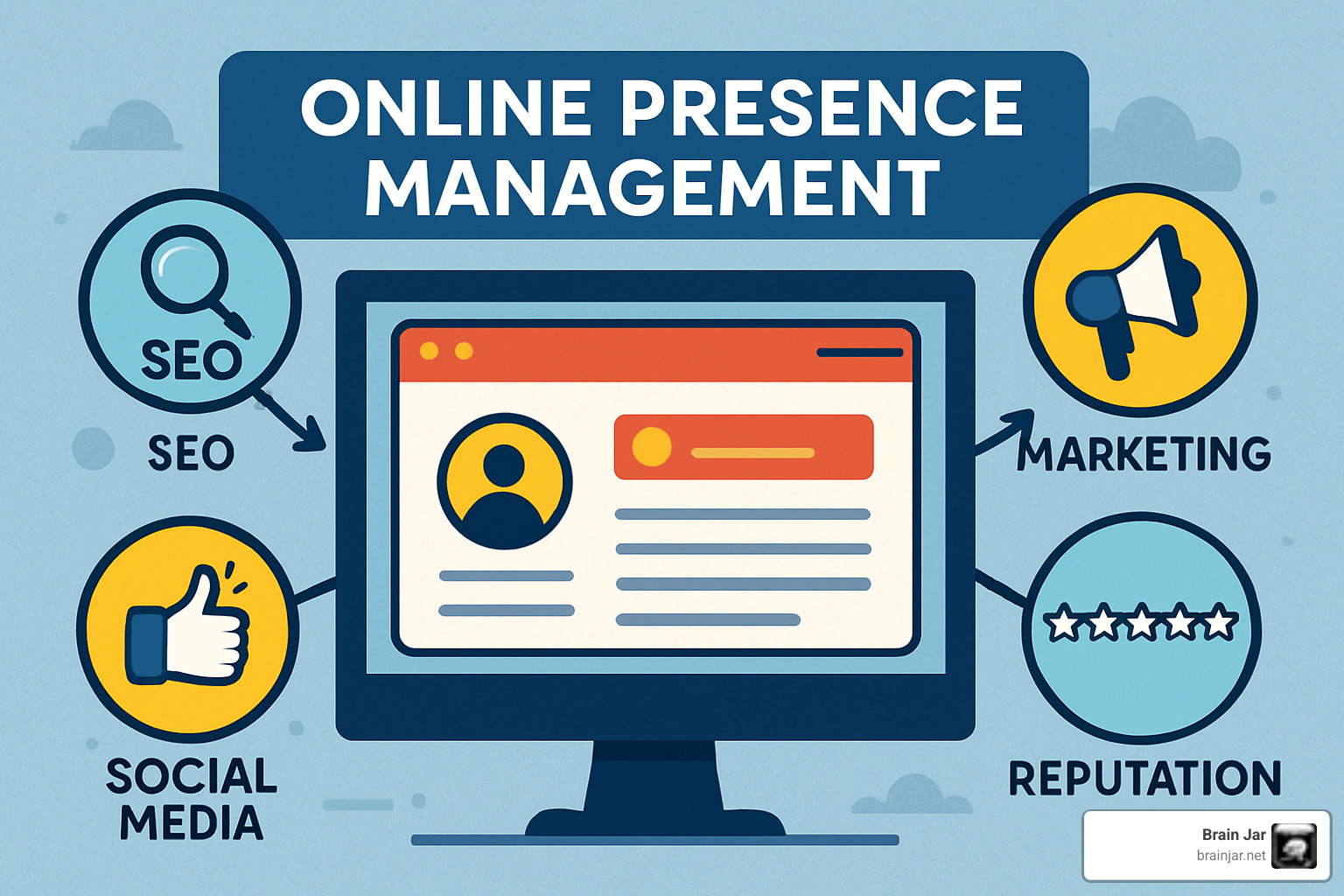
Frequently Asked Questions about Online Presence Management
How often should I audit my online presence?
The short answer is quarterly for comprehensive audits, but some things need more frequent attention. Your review sites and social media deserve weekly attention at minimum. Customer feedback moves fast, and delayed responses can hurt your reputation.
Monthly check-ins work well for tracking key metrics like search rankings and website traffic. The comprehensive quarterly audit is where you dive deep – check all your online listings, analyze competitor activity, and assess whether your current approach is meeting business goals.
Your industry matters too. Healthcare, legal services, or hospitality businesses often benefit from more frequent monitoring since reputation issues can escalate quickly.
What’s the fastest way to improve local search rankings?
Start with your Google Business Profile – it’s the single most impactful action you can take. Claim it if you haven’t already, then optimize every section. Add photos, write a compelling description, and keep your hours updated.
Consistency is crucial for local SEO. Your business name, address, and phone number must match exactly across every platform. Even small differences like “Street” versus “St.” can confuse search engines.
Reviews are your secret weapon. 84% of consumers trust online reviews as much as personal recommendations. Create a system to encourage them – send follow-up emails after positive interactions with direct links to your Google Business Profile.
Local content on your website helps search engines understand your geographic relevance. Write about community events, local partnerships, or area-specific services.
How do I handle fake negative reviews?
First, investigate thoroughly. Sometimes reviews that seem fake are actually from customers you don’t recognize. Document everything if you determine the review is genuinely fake. Look for red flags like accounts with no review history or impossible service dates.
Respond professionally even to fake reviews. Other customers are watching how you handle difficult situations. A calm, professional response shows you care about customer satisfaction.
Be patient with the removal process. Platforms need time to investigate properly. While you wait, focus on encouraging legitimate customers to leave reviews – positive reviews naturally dilute the impact of negative ones.
Conclusion
Building a strong online presence management strategy isn’t just about keeping up with digital trends – it’s about creating genuine connections with customers who are actively searching for what you offer. The numbers we’ve shared throughout this guide tell a compelling story: customers make decisions based on what they find online, and those first impressions happen whether you’re actively managing them or not.
Think of online presence management as building a digital home for your brand. Just like your physical location needs maintenance, updates, and attention to detail, your online presence requires ongoing care and strategic thinking. The difference is that your digital presence never closes – it’s working for you 24/7, either attracting customers or potentially sending them to competitors.
The roadmap we’ve outlined gives you a clear path forward, but this is a marathon, not a sprint. The businesses that see the best results are those that commit to consistent, authentic engagement across all their digital channels. Your website, social media profiles, review responses, and content should all feel like they’re coming from the same trustworthy source.
What makes the biggest difference is creating that seamless experience where everything works together. When a customer finds you through search, visits your website, checks your reviews, and follows you on social media, they should feel confident that they’re making the right choice. That confidence translates directly into phone calls, appointments, and sales.
At Brain Jar, we’ve spent years helping businesses in Southern California and beyond turn their digital presence into a powerful growth engine. We understand that every business is unique, and cookie-cutter approaches rarely deliver the results you need. Whether you’re just starting to build your online presence or looking to optimize what you already have, having experienced partners can make all the difference.
The digital landscape will continue evolving, but the fundamentals remain the same: be helpful, be authentic, and be consistent. Focus on serving your customers well, and the technology will support your efforts rather than overwhelm them.
Ready to transform how customers find and choose your business? Our comprehensive social media management services can help you build the kind of online presence that not only attracts customers but turns them into loyal advocates for your brand.
